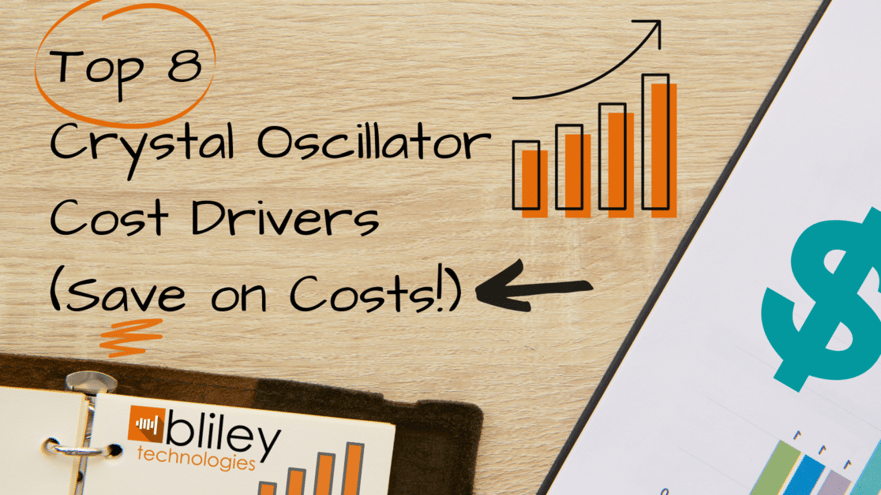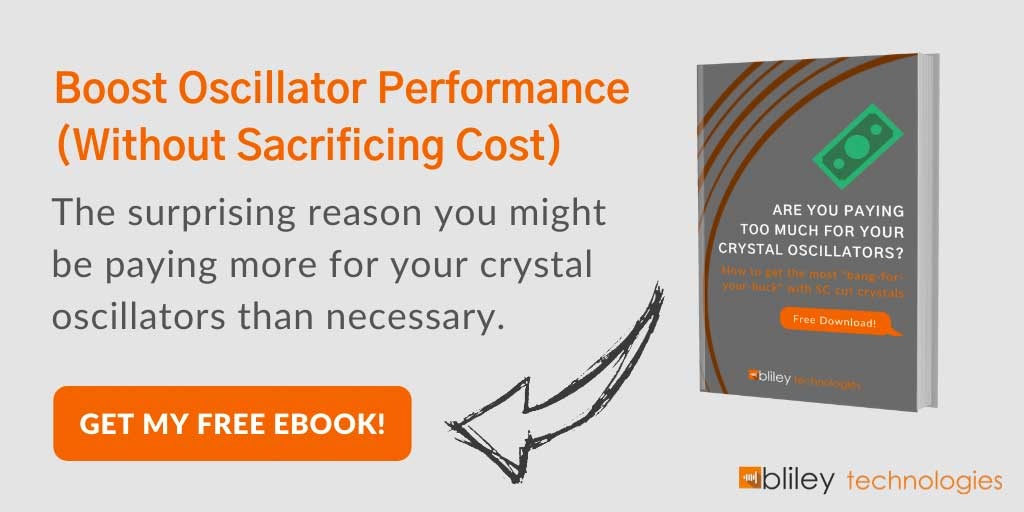
One of the key things you need to know before purchasing a crystal oscillator is the expected cost. There are many specifications that can quickly drive up (or down) the costs of OCXOs and other crystal oscillators. In this post, you'll learn the top eight cost drivers for crystal oscillators ranked from most to least impactful.
By the end of this post, you'll have a much better idea of where to focus your cost-cutting efforts and how to save the most in the long term. Much of it depends on the needs of your specific application and where you're able to be more flexible.
Note: Oscillator pricing is very dependent on your specific needs and application. Be sure to contact us for specific information and pricing based on your needs.
The Top 8 Crystal Oscillator Cost Drivers (Ranked by Cost Sensitivity)
- G-sensitivity
- Phase noise
- Operating temperature
- Stability (FvT)
- Allan deviation (ADEV)
- Voltage
- Frequency
- Package size
Let's dive deeper into understanding each cost driver.
.png?width=537&name=Top%208%20Crystal%20Oscillator%20Cost%20Drivers%20(1).png)
1. Oscillator G-Sensitivity
Not everyone needs g-compensated oscillators in their application. But if your application is subject to high levels of vibrations, g-forces, or micro-vibrations (or if you work in an industry such as military or space), odds are you will need to consider g-compensated oscillators.
G-compensated oscillators (also called g-sensitivity or high-vibration oscillators) can get expensive. Whenever the crystal inside an oscillator is exposed to vibration or g-forces, it can quickly and dramatically throw off the oscillator's desired center frequency.
A lot of technical engineering goes in to making an oscillator resistant to g-force and vibration deviations to maintain that desired frequency and phase noise. This is especially important in critical military and defense applications.
The very technical and precise nature of g-compensation drives up the cost of an oscillator very quickly. The more g-compensation that's needed, the higher the cost.
Active and passive compensation are two of the main methods used in effective g-sensitivity oscillators. It also helps to use high-stability crystals.
2. Oscillator Phase Noise Requirements
There are so many potential external factors that can lead to unwanted phase noise in crystal oscillators. These include vibrations, temperature deviations, aging, and more. Similar to g-compensation, a lot of fine engineering technicalities go into keeping oscillators free of phase noise. This naturally causes the process to become more costly.
The more phase noise resistant an oscillator needs to be, the more difficult it is to manufacture an oscillator that maintains a clear, stable frequency over time, and (typically) the higher the cost will be.
Related: The Ultimate Guide to Understanding Phase Noise
3. Operating Temperature Range
An oscillator's operating temperature earns the #3 spot on our cost sensitivity list. The wider the oscillator's operating temperature range becomes, the more difficult it is to design and manufacture to maintain a precise frequency or phase noise level.
Therefore, the wider the required operating temperature range, the higher the costs usually are (assuming all other specifications remain untouched). While temperature range might not impact costs as much as g-compensation or phase noise requirements, it is still a significant source of potential added costs.
Related: Can a Crystal Oscillator Operate Outside of the Specified Temperature Range?
4. Long-Term Oscillator Stability (Frequency vs. Temperature)
Crystal oscillator stability (frequency vs. temperature, or FvT) is very similar to g-compensation in that it can be very technically challenging from an oscillator design perspective to maintain high stability over a long period of time.
External elements such as temperature deviations can cause the oscillator frequency and phase noise to drift. A lot of technicalities go into the crystal cut and oscillator unit itself to help maintain the precise frequency and/or phase noise level over time. This drives up costs — potentially very quickly. The higher the stability needed, the higher the costs will be (assuming everything else is constant).
Related: 4 Top Factors That Influence Crystal Oscillator Frequency Stability
5. Allan Deviation (ADEV)
Allan Deviation, in simple terms, can be translated to short term stability. ADEV drives up costs just like long-term oscillator stability (FvT), but can be much less difficult to maintain (from a manufacturing perspective).
Therefore, higher ADEV requirements will not drive up costs as fast as FvT.
6. Oscillator Input Voltage
While input voltage doesn't typically play a significant role in an oscillator's cost, it should still be noted.
As an oscillator's input voltage requirements are lowered, the harder it becomes to hit performance. This can drive up the costs. Basically, the lower the voltage (while trying to achieve best performance), the higher the costs are likely to be.
7. Oscillator Frequency
If all else remains constant, an oscillator's center frequency requirements can be significantly adjusted without much additional costs added. Exceptions include very odd/custom frequencies (that aren't commonly used in many applications) or very high frequencies. Yield will be impacted on the crystals.
8. Package Size
Oscillator package size has the least influence on costs, but it makes enough of a difference to be worth mentioning here.
The smaller the package dimensions, the harder it becomes to fit in all the required oscillator circuitry and electronics. This is especially true if there are a lot of heavy requirements in other areas (g-compensation, phase noise, temperature range, etc.). Typically, the smaller the package, the higher the costs.
How to Boost Oscillator Performance (Without Sacrificing Cost)
We hope you've found our list of the top cost drivers of crystal oscillators helpful. Check out our free guide below to learn more about how to make your designs even more cost efficient.
Need to find the perfect oscillator for your application? Browse our full product line!






